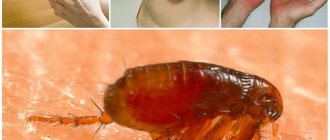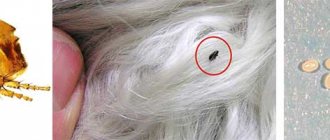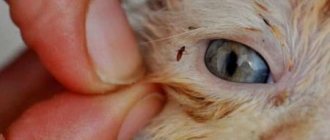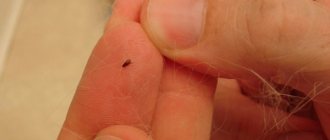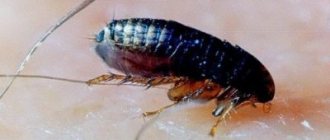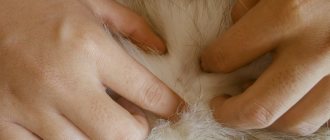Types of fleas that live on pets
There are many varieties of fleas. Each species is adapted to the blood, body temperature and other characteristics of its owner. But, if he is not nearby, fleas are able to be content with other animals or people who are within reach.
Pets can be infected with the following parasites:
- Cat flea. Can carry brucellosis, plague and other infections. It feeds on the blood of not only cats, but also dogs. The development of larvae occurs in the bedding and fur of pets. The size of the insect is 0.8-4 mm. Can live up to 2 years.
- Dog flea. Lives on dogs and cats. A dog flea bite can trigger the development of ctenocephalosis. The insect reaches a size of 0.8 mm. Adults lay eggs in the pet's fur or bedding. The parasite lives on average 1.5 years.
Can fleas from a cat transfer to the human body and bite?
How to stop a dog from jumping on people when they meet you
Most often, fleas bite human legs: ankles, ankles, and the area up to the kneecap. They easily fall under clothing, so it is unlikely that they will be able to escape with its help. Having a tiny size, they easily penetrate through the weaving of threads, between the seams.
Flea bites can be seen on the legs
Clothing treated with repellent spray helps protect against their invasion. Permethrin is a broad-spectrum insecticide. It is applied to clothing, adheres tightly to its fibers and has protective properties for a long time, up to 6 weeks. Even after washing it retains the protective effect.
It’s worse if the cat is trained to sleep in the owners’ bed. Then fleas can be easily transmitted to humans from the cat through bedding. They will not live on a human body, but they will bite quite a bit. In this case, bite marks can be observed throughout the body. If you notice itchy pimples, the first thing you need to do is examine your cat for parasites.
How to determine what fleas have bitten
At the site of the bites, you can see a very tiny, barely noticeable point, around which an inflamed pinkish spot has formed. More often there are several swellings grouped in one place. This is caused by the fact that the flea has a too short proboscis with which it pierces the skin. The bloodsucker searches for the most vulnerable spot by pulsating blood vessels, making several punctures next to each other. It digs in, going headlong into the upper layer of the epidermis and taking on an almost vertical position. The moment of the bite itself is rarely seen. The itching lasts about 2-3 hours, then subsides. It may occur periodically, causing intuitive scratching of the affected area. You can relieve irritation:
- treating the bite site with an alcohol-containing preparation or iodine (or hydrogen peroxide);
- lubricate with a cream containing steroid drugs;
- taking an antiallergic drug.
Important! If any adverse reactions are detected, you should immediately go to the hospital.
The bite site can remain inflamed from 3-4 days to 1-2 weeks or more, depending on the body’s sensitivity to various types of irritants. Subsequent bites can significantly increase recovery time in immunocompromised individuals suffering from chronic diseases and cancer. In people with strong immunity, partial or complete desensitization occurs - a complete absence of the body's reaction to bites.
Allergic reactions to bites in children have a complex form
Young children have very weak protective functions of the body; their immune system is just developing. The entry of foreign substances into the blood causes a powerful allergic reaction. The child should be immediately given first aid and protected from contact with insects. Long-term intoxication has an accumulating effect and can lead to complications.
- The most common immediate reaction is hives. With it, pronounced inflammation has irregular contours with a diameter of up to 5-15 mm. Accompanied by itching and redness lasting 5-30 minutes. It passes without leaving traces.
- After a person has been bitten by fleas (after 12-24 hours), papules may form - small nodules of a cavityless formation 2-3 mm in diameter, surrounded by an inflamed reddish area of 1-2 cm. They disappear in 3-4 days. In rare cases, they remain as scars.
- In some cases, vesicles form. Liquid accumulates in the blisters, and the surrounding skin turns red. Over time, they heal, leaving areas of darkened skin.
- Secondary infections resulting from scratching the bite site are more dangerous than the bite itself. Damaged skin is an excellent place for bacteria to develop. Infected areas tend to fester, and then flicterns with purulent or serous contents are formed. When a large surface of the body is infected, an abscess cannot be avoided.
Flea bites are especially dangerous for people who are allergic to any type of insect bite.
Are cat fleas dangerous for a healthy person and what diseases do they carry?
Of course, they do not pose a danger to the life of a healthy person, but they can cause serious diseases transmitted by parasites. And there are quite a few of them, more than 20. Some can cause irreparable harm to health and lead to disability. In elderly people with weakened body functions, even ordinary non-healing bites can provoke disturbances in the functioning of the nervous and cardiovascular systems. In infants, there are severe allergic reactions with attacks of suffocation and loss of blood due to its strong dilution. In addition, additional infection is possible, which can lead to a tragic outcome.
- Cat fleas carry the following types of diseases: plague, fever, murine typhus, helminth infections, sarcopsillosis.
- Rat fleas that get on a pet can subsequently bite the owners. They are carriers of typhus, salmonellosis, trypanosomes, encephalitis, and malaria.
Flea saliva contains up to 15 different types of substances, and is therefore a strong allergen.
Why not all people are bitten by fleas
Many people are sure that fleas do not bite all people. It is a myth. Simply, during a bite, bloodsuckers inject saliva, which prevents blood clotting. Therefore, in people who are immune to inflammation, the bite sites are completely invisible. Some people don't even feel itching from the bites. Also, fleas are not able to bite through clothing (except for nylon tights). But it’s not difficult for bloodsuckers to get under it.
Development cycle
Life cycle of a flea.
The life cycle of a flea has several stages:
- egg;
- larva;
- chrysalis;
- adult.
At temperatures of +18...+25°C, insects can reproduce all year round. At lower temperatures, the reproduction process stops. Females lay eggs in small groups. After 2 weeks, legless larvae begin to hatch.
In appearance they resemble worms. After 3 moults, the larvae transform into pupae, which are wrapped in a cocoon. This stage lasts 2-3 months. The pupa then develops into an adult.
The main types of harmful insects living on pets
The most frequently asked question is: are fleas transmitted from cats to humans? In order to answer it, you need to understand the main types of insects and the conditions under which they are transmitted.
There are several types of fleas, each of which adapts to the individual characteristics of its host: body temperature, blood composition and other characteristics. If there is no living organism nearby that satisfies the parasite in all respects, then the flea easily switches its attention to another representative of the animal kingdom or to people.
cat flea
The most numerous species of the Flea order. Adults have a flat body covered with bristles, a small head and a large red or brown abdomen. The oral cavity of the insect, upon closer examination, looks so that there are no questions left about whether cat fleas can bite painfully enough.
While the insects are motionless, they look much like small pieces of dirt stuck to your pet's fur.
The flea's hind limbs are well developed, with their help it can jump quite high. The flea reproduces very quickly. The female lays eggs, similar to white grains, in secluded places: genital crevices, upholstery of upholstered furniture, in carpets and rugs.
It is from the activities of representatives of this species that people suffer the most: fleas from cats are transmitted to humans 3 times more actively than from dogs. The main negative quality of representatives of the species is that fleas in cats are dangerous to humans.
Malicious insect and dogs
A representative of the Flea order, parasitizing primarily on dogs, but in the absence of a main carrier, they can feed on the blood of humans and other warm-blooded animals: horses, cows, cats.
Parasites can go without food for about 2 months, hibernating. Dog fleas are very jumpy.
The length of the jump is four times the distance they can see. The size of an adult is up to 0.5 cm. Color – from dark yellow to brown. They move around dogs very quickly with the help of bristles and ridges located in large numbers on the body. Feline and human representatives of the species can also be transmitted to dogs.
Human fleas
Pulex irritans prefer to eat human blood. If they fail to detect people nearby, they can be transmitted to other mammals: cats, dogs or horses.
Anyone can become food for a human flea. Adult representatives of the order are brown-black in color and measure about 4 mm. The main danger posed by pests is their ability to transmit various diseases.
Features of parasitism
Insects feed on the blood of cats, but in their absence they can attack other animals and even humans. The oral apparatus of cat fleas has such a structure that it allows them to feed exclusively on blood. The parasite has a short proboscis, which is why when eating it takes a vertical position, and part of the body is located in the wound.
The flea makes several punctures with its proboscis. During the bite, saliva is injected into the wound, causing allergic reactions, dermatitis, papules, etc. in the animal.
When it is satisfied, it leaves the victim's body.
A kitten can become infected with pests from its mother. Flea parasitism causes severe itching in the animal. The cat begins to scratch its skin until it bleeds, which is why it becomes irritable. She may experience hair loss, quite intensely. Treatment of the pet is carried out using shampoos, collars, sprays, insecticides.
How to treat bite sites?
Although the answer to the question of whether fleas live on humans is negative, the danger posed by these jumping cat parasites cannot be ruled out in any case.
Having found bite marks, the part of the body where they are found should be washed with warm water and antiseptic soap and dried. Then apply an antiseptic solution to the skin, especially in cases where the person has been severely bitten. Recommend:
- an aqueous solution of vinegar or citric acid;
- calamine solution;
- hydrocortisone ointment;
- Fenistil-gel.
Calamine solution is a natural remedy. It has antiseptic properties, reduces inflammation, relieves itching, swelling, and redness. Suitable for children. Side effects are minimal.
Hydrocortisone is a hormonal drug that relieves itching and effectively fights inflammatory processes. There are contraindications and side effects.
Fenistil-gel is an antihistamine (anti-allergic) and anesthetic drug for children after 1 month and adults, relieves itching and burning of the skin. The basis of the drug is dimethindene. There are side effects and contraindications.
Before using these products, you should consult your doctor to avoid side effects and allergic reactions.
The danger of cat fleas to humans
Cat fleas do not live on the human body due to the lack of dense hair, but they can jump on it to satisfy their hunger. They are dangerous for people because they can carry many serious diseases: plague, intestinal yersiniosis, pasteurellosis, listeriosis, tularemia, trypanosomiasis, hepatitis B and C, encephalitis, typhus.
Parasite bites can lead to the following consequences:
- cause allergic reactions, which are manifested by skin rashes, fever, difficulty breathing and even anaphylactic shock;
- provoke inflammation of the skin, resulting in the formation of dermatitis;
- capable of infecting with brucellosis, which causes damage to internal organs and death, or creeping erythema, which is manifested by constantly occurring ulcers and peeling of the skin.
Parasites can get into food, which, if consumed, can cause severe poisoning.
An extremely dangerous disease that a person can become infected with is anthrax. The infected person develops hematomas and erosions, and internal organs are affected. This leads to general intoxication of the body and death.
Flea bites.
Are fleas transmitted to humans from cats?
Cat fleas cannot live on the human body because there is too little hair on it, and the temperature is lower than what the parasites need for normal metabolism. In addition, humans have much thicker skin than a cat’s; pests have difficulty biting through it.
But if the flea is hungry, it can move onto the human body to drink blood, after which it leaves the victim.
Do they bite people?
Cat parasites bite people to satisfy the hunger they experience if the cat is heavily infested with fleas. Most often they bite open areas of the human body - legs, arms, stomach, back. They often attack people with thin skin, who do not have excess fat, and whose blood vessels are located close to the surface of the skin.
Are fleas transmitted to people?
Are fleas transmitted from cats to humans? A word such as “transmitted” in this case will not be very true. The attack of the little “vampire” will be short-lived and is aimed solely at satisfying the feeling of hunger. Only for this purpose do parasites temporarily move onto people. They have no other plans for the person. They choose darker, damper and warmer places to lay eggs. If the parasite is well-fed, then the human body is completely indifferent to it. During this time, he will live in garbage, cat and dog litter. Fleas pass from animals to people as soon as they get hungry. Then they will attack anyone who is nearby and suitable as a source of blood. The most dangerous places for a person to experience a painful flea bite are: doghouses, animal bedding, contaminated premises, and basements.
Caught flea
Most often, fleas jump from cats onto people. They dominate the flea niche. Even human and dog fleas bite much less often. In this case, a reasonable question arises: can a person become infected with fleas from a cat? Fortunately, no, these bloodsuckers cannot live on people, but they can bite.
To prevent flea bites, it is imperative to take measures to eliminate parasites from cat and dog fur. You should regularly treat animals, as well as their bedding, with special products (sprays, gels, shampoos), and put a flea collar on them.
Signs of fleas in humans
Blood-sucking insects from the flea family bite very hard. They do not have a proboscis for sucking blood, so they literally bite into the skin. In this case, the insect first pierces the skin with its teeth and injects an anesthetic substance, and then an enzyme to reduce blood clotting. At first the victim does not feel the bite, and during this time the flea manages to drink enough blood. After a few minutes, the bite site will turn red, itching and burning will appear. You will want to scratch the wound. This happens because the anticoagulants and anesthetics injected by the blood-sucking insect are foreign to the victim. As a result of scratching, red itchy spots are formed that disfigure the skin. Most often, fleas attack human feet. But if insects have settled in the bed, then the entire body will be covered with bites.
This is what the human body looks like after flea activity
Signs of bites
Signs of cat flea bites:
- Severe burning and pain at the site of the lesion. The saliva of parasites contains a special enzyme that prevents blood from clotting, so their bites are painful and bleed.
- Blisters appear on the affected area and severe swelling appears.
- Flea bites are located at a distance of 2 cm from each other and look like small constellations.
- A severe allergic reaction occurs.
Cat fleas can bite a person at any time of the day.
How to distinguish flea bites from other insects?
Flea, bedbug, and mosquito bites are similar. But the first one has its own characteristics:
- Leaving a track of 11-12 cm from 2-3 punctures.
- The appearance of swelling with a dot in the center.
- Damage to feet, legs, hands. Bedbugs, for example, can leave marks on any part of the body.
- The ability to bite at any time, bedbugs bite only at night.
- The appearance of severe, but quickly passing (1-24 hours) itching.
Additional Information! Crushed bedbugs leave brown stains on mattresses and sheets. Fleas are almost invisible. Even severe pain during a bite does not appear for long. Not every person can feel a flea bite unless they have delicate, hypersensitive skin. Unlike other insects, fleas practically do not secrete an anesthetic element when they bite due to the dense chitinous cover and flat body of the body. They simply stick to a person and begin to suck blood, lowering their proboscis into the skin, pressing in in an attempt to reach a blood vessel.
Treatment of bites and control of parasites
Treatment will be required if the discomfort after the bite does not go away within several days or the pain becomes unbearable. The use of various agents depends on the characteristics of the human body and the symptoms of the lesion.
If itching occurs:
- treat the wound with soap and warm water, then wipe with alcohol or hydrogen peroxide;
- Apply an ice cube to the bite site.
You can also eliminate the burning sensation with calamine solution, sulfur ointment, or a weak solution of baking soda. If an allergy occurs, this condition should be treated with antihistamines - Diazolin or Suprastin, sedatives, and medications that reduce body temperature. A universal remedy that is used to treat bites is hydrocortisone ointment. Apply it to the wound immediately after the damage is detected.
When fleas appear in an apartment, you need to start fighting them immediately. First, it is necessary to cure the infected cat, and then treat the premises to protect the people living there.
Effective remedies for treating flea bites.
To eliminate fleas from an animal, special means are used:
- Drops on the withers - Advantage, Api-San, Lawyer, Frontline Spot on Cat, Bars. They are suitable for both adult pets and kittens. The drug contains an insecticide - methoprene or fipronil.
- Sprays - Bars, Frontline. They contain the same basic components as the drops, but they differ in the method of application. Valid for 1-2 months.
- Collars - Foresto, Bars, Beaphar. Such products are impregnated with insecticides, and the effect of their use lasts 2-3 months.
- Shampoos - Doctor ZOO, RolfClub, Bearhar Bio Shampoo. They are used as part of complex therapy. The preparations contain insecticides, as well as herbal, moisturizing and cleansing components.
After treatment, the animal cannot be bathed for 3 days.
Transfer options
The ways in which parasites appear on a cat and in an apartment are different:
- the risk of infecting a pet while walking: from stray animals, near garbage dumps, basements, where entire colonies of parasites can usually be found;
- if the cat or male cat is domestic: when visiting a veterinary clinic, when moving to the countryside for the summer, on public transport, carrying is not a barrier;
- in search of a victim, parasites can move along risers, pipes, and enter the room through ventilation openings; residents of the first floors are especially susceptible to attack;
- in a private house: from chickens, cattle, from rats that have settled in a cellar or basement, any animal can bring insects to the local area;
- apartment residents can bring larvae or adults on themselves, on their shoes, or on their clothes;
- guests coming to your house can bring a parasite.
There are plenty of ways for pests to appear, so you should carefully monitor the condition and behavior of your pets. If you get bites, it doesn’t hurt to immediately take action and understand the reasons for their appearance.
Flea remedies
| Pharmacy name | Address | Product name | Price |
| New meetings on Old Arbat | Moscow, st. Arbat, building 30, building 1 | BlochNet drops 1 ml for cats against fleas and ticks | 68 rub. |
| SeaZOO | St. Petersburg, Engelsa Ave., 27 | Frontline Spot He drops on the withers for fleas | 324 rub. |
| ZooBazaar | Minsk, st. Moskovskaya, 22 | Hartz Flea and Tick Powder for Cats | 330 rub. |
| Darling | Kiev, Kharkov highway, no. 152 | Stronghold for cats against fleas | 219 gr. |
Are cat fleas dangerous when they are transmitted to humans, cats and other animals?
Parasite bites are very painful, so they bring a lot of discomfort: inflammation, rashes, unbearable itching, possible abscesses or suppuration. Scratched wounds are an open source for infection.
What is the danger for cats, cats and other animals:
- deterioration of physical or mental condition;
- likelihood of allergic dermatitis;
- helminthiasis infection;
- the possibility of infection with fungal diseases, mycoplasmosis, which affects organs, rickettsiosis, which causes fever;
- when neglected, there is a possibility of partial or complete baldness of the animals; after losing hair, a new one simply will not grow back.
Danger for kittens:
- rapid weight loss plus slowdown (or cessation) of development;
- anemia, which often leads to the death of kittens.
Danger for pregnant and lactating cats:
- loss of useful nutrients necessary for the animal’s body;
- infection with toxins during drug treatment;
- negative heredity for kittens.
Are cat bloodsuckers dangerous for people?
- when punctured, an anticoagulant enters the human blood - a foreign substance that prevents blood clotting;
- negative reaction of the immune system: allergies, itching, burning, tumors, inflammation.
Main danger
The most serious danger is that ectoparasites are carriers of terrible diseases: typhoid, anthrax, erythema creeping, salmonellosis, brucellosis, mass dermatitis and many others.
Particularly dangerous in this sense are rat bloodsuckers, which were responsible for the death of a huge number of the European population in the Middle Ages.
But where is the guarantee that your cat will not carry a rat, which is considered the most dangerous on the planet. If cat insects prefer the blood of cats, then they attack people in case of urgent need to find food. Rat parasites are not selective, it doesn’t matter to them which warm-blooded animal they feed on, the main thing is to be well-fed.
Moreover, cat flea bites on humans are a guaranteed infection with worms - helminths, see photos of the consequences of an attack by harmful insects.
How to detect parasites in cats:
- loss of appetite in the animal;
- aggressiveness, anxiety, refusal to communicate with the owner;
- the cat bites into the body, which is associated with painful sensations from bites;
- when examining the pet’s body, you can see red spots, inflammation, wounds, ulcers;
- if you part the fur, you can see the parasites themselves.
It is necessary to take immediate action and decide how to get rid of cat fleas.
Pet treatment
To treat your pet, you will need special products, of which there are a sufficient number on sale: shampoos, drops, sprays, tablets, powders, collars. Be sure to read the instructions, as all products are selected individually. Age, weight, height, general condition and even the breed of the animal are taken into account.
There are a lot of effective folk remedies that are easy to prepare yourself.
Regardless of the choice, it is necessary to carry out processing as quickly as possible. This is the key to avoiding serious problems.
What to do and how to get rid of parasites if cat fleas bite people? First of all, it is necessary to take emergency measures to treat the affected areas.
Many people are interested in whether it is possible to wash and treat bite sites. It is possible and necessary.
Urgent measures:
- wash the wounds with soapy water;
- treat with any antiseptic: brilliant green, iodine, etc.;
- apply ice or a cold compress to the sore areas;
- apply any antihistamine: fenistil gel, psilo-balm, bepanten, etc.;
- medications are necessary to relieve itching and inflammation;
- if nothing is at hand, you can treat the wounds with alcohol, vodka, even cognac.
Such measures will stop the spread of infection and relieve pain.
After treating your wounds or lesions on your pet, you need to think about how to quickly and efficiently get rid of cat fleas in your apartment if the pet lives in your living space.
Cleaning an apartment from fleas
Most often, fleas do not live on a pet, but hide in secluded corners of the apartment. Therefore, after treating the animal, it is necessary to treat the room. First, it is recommended to vacuum the cat's bedding, furniture, carpets, wash soft toys and linens, and do wet cleaning. After this, the room is treated with a composition against such parasites. This can be a concentrate for preparing a solution (Chlorpirimak, Biorin) or a spray (Kombat, Raptor).
You can treat your cat's bedding with insecticides. After all the actions, the room is ventilated and left for 2-3 days.
If this is not possible, you should treat areas where people will be with soapy water. If there are too many fleas, you need to seek help from an exterminator.
How to get rid of parasites
The first thing to do is to clean the apartment of fleas. It will definitely not be possible to cope with the situation in one go. Since the eggs from which new individuals emerge do not all hatch at once, repeated disinfection will be required, otherwise pets will become infected again. You need to thoroughly vacuum, or better yet, clean carpets and cat litter with special insecticidal agents, treat baseboards and floors with dichlorvos or another antiparasitic drug, rinse them after a couple of hours, clean upholstered furniture, wash soft toys.
Self-treatment of an apartment for fleas
If fleas are widespread throughout the house, it is better to seek the services of specialists. Neither people nor animals are allowed to be in the house at this time, as the team of workers uses potent drugs.
Note! After using products with a persistent odor, the apartment must be well ventilated.
Is it possible to get rid of it using folk remedies?
You can fight fleas using folk remedies, but it is difficult to achieve the desired effect. Herbs help: wormwood, tansy. Place fresh plants under upholstered furniture, along baseboards throughout the house, and in areas where cats sleep. After 1-2 days, remove and replace with freshly picked herbs. The floors are washed with an infusion of the same plants every day until a noticeable result is achieved.
How to remove parasites from a cat
Along with disinfecting measures in the apartment, it is necessary to treat the pet itself. First, bathe with tar or dust soap. Dry and apply a special anti-parasitic drug to the withers. They are sold at any veterinary pharmacy. After application, the product slowly penetrates the blood, making it unsuitable for blood-sucking insects. It has paralyzing properties, so the parasites try to leave their habitat because they lose the ability to move normally.
It is necessary to additionally put a special flea collar on the animal. Many people believe that it is harmful because it is constantly on the animal. This is wrong. Impregnated with special anti-flea preparations that protect against all types of fleas and dangerous ticks, it will protect your ward from subsequent infection during walks.
Important! Products for parasites are very toxic and are dosed depending on the weight of the pet. An overdose is dangerous for animals, so you must strictly follow the attached instructions. If there are signs of dermatitis on the animal’s body, the drugs can cause intoxication of the body and lead to death. Before use, consultation with a veterinarian is necessary.
Preventive measures against re-infection
To prevent re-infection of the premises and the animal with fleas, it is recommended to follow the following preventive measures:
- treat your cat with anti-flea medications once a month;
- regularly wash the animal’s bedding or bed;
- maintain cleanliness in the apartment, carrying out thorough wet cleaning as often as possible;
- When fleas appear, you must immediately take measures to get rid of them.
Only in this case can you get rid of parasites that are harmful to both animals and people.
Source
How to Avoid Bites
Fleas can be transmitted from animals, so if suspected, you need to get rid of them immediately. If guinea pigs, cats, dogs, rabbits, and birds live in the house, then preventive measures should be carried out in a timely manner.
Important:
- Inspect pet fur. Periodically treat with special drops (Hartz, Frontline, Advantage, Bars, Rolf.) The main thing is that pets do not lick them off.
- Wash dogs with special shampoo after walking, add pine sawdust to the bedding. Use collars.
- Maintain freshness and cleanliness in the house, wash floors more often with the addition of ammonia, bleach, and wormwood to the water.
- If parasites appear, spray the room with Dichlorvos.
- Fight chicken fleas. Treat poultry houses and poultry farms with essential oils: lavender, wormwood, tansy. Sprinkle chicken coops with wood ash.
- Cover all parts of the body with thick clothing when going to the forest, hunting, or lakes.
Fleas inject saliva into human blood, which contains a large number of viruses. Parasites are carriers of infectious diseases: pseudotuberculosis, brucellosis, anthrax, tularemia, pasteurelosis. Some of them, if timely assistance is not provided, can result in death.
Can fleas be transmitted from humans?
Sometimes a person himself transmits the pest to his pets. Hunting, fishing, business trips, travel are the main activities during which fleas can be transmitted to a person. Particular attention should be paid to the places chosen for overnight stays, where nuisance transmission may occur. Sometimes entire flea colonies live in the bed of a cheap hotel room and have a negative impact on humans.
There is a misconception that fleas do not bite all people, being guided by their individual smell. In fact, the parasite doesn’t care who it bites. This opinion arose, first of all, from the fact that fleas bite people mainly at night, and many simply do not feel their bites during sleep. The absence of bite marks can be explained by the characteristics of the skin of each individual: men, for example, are less likely to notice traces of the activity of small bloodsuckers on their skin.
